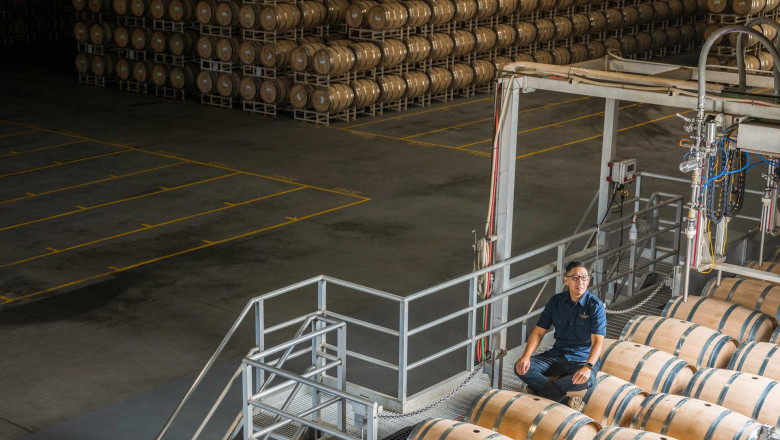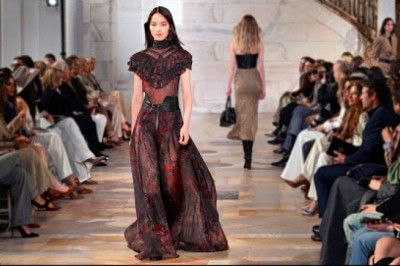
views
Countless pages, podcasts and programs have been devoted to the romantic sagas of iconoclastic vintners who make boutique bottlings from tiny, hand-tended blocks in dramatically challenging vineyards. But the vast majority of wine lovers cannot find or afford those wines, especially those just starting out on their wine discovery journey.
Instead, neophytes and veterans alike seek enjoyment from wines that are made in much larger batches, from tens of thousands to more than one million cases each vintage. These bottles dominate the shelves of grocery stores and restaurant lists nationwide, retailing from about $25 down to less than $10 apiece.
Elitists regularly rail against such affordable and accessible offerings—as happens in every craft that equates being small with being special. There are certainly examples of brands that cut corners in ways that aren’t friendly to the palate, to transparency or to the environment, which happens on both ends of the quantity spectrum. But many of these big brands exhibit a captivating degree of consistent quality, and that’s thanks to the real people working just as diligently as their small-batch brethren to create wines of substance and style.
These winemakers might serve the most critical role in American wine: producing bottles that can be enjoyed every day, introducing new wine consumers to the market and educating the next generation who come up through their ranks. They’re also on the leading edge of innovation, with the expansive budgets and expendable batches required to test new technologies, develop their own and share their research with everyone else.
“Big winery wines often get a bad rap—you never get to see the people behind the brand, so they just become faceless,” says Beth Liston, who makes an extensive lineup of roughly $10-a-bottle wines for E. & J. Gallo’s Dark Horse Winery. “But there’s myself and a large team of winemakers and wine growers that go into getting every bottle to the market.”
Thank You! We've received your email address, and soon you will start getting exclusive offers and news from Wine Enthusiast.
Raised in Santa Maria among the small wineries on California’s Central Coast, Liston only expected to stay with Gallo for two years, not wanting to be classified as a large-winery winemaker. “That was 15-plus years ago,” she says. “Obviously, my perspective changed.”
The biggest initial difference you find in approaching winemakers from bigger brands is that inquiries are vetted by the marketing department, whereas smaller winemakers simply pick up the phone. But once that hurdle is jumped, these vintners sound exactly like the single-block fanatics, talking constantly of vineyard visits, of picking on taste, of fermenting in barrels— just lots and lots of vineyards and tastes and barrels.
“It’s counterintuitive, but our scale allows us to focus on winemaking,” says Brenden Wood, who’s in charge of J. Lohr’s 30 different red wines, including the one million-case Seven Oaks Cabernet Sauvignon. “We really get to spend time tasting out in the vineyard, as opposed to worrying about if the hydraulics on the forklift are working right.”
Wood is equipped with reams of data and tools to do so, from proprietary yeast strains to daily reports on tannin, phenolic and nutritional levels. “We can get really detailed and dorky,” says Wood, a Bay Area native who started making beer while still in high school and came to J. Lohr in 2004. “If we want a fermentation that goes really quick to get more color early, we can do it that way. Or if we want to slow it down, we can be really picky about those fermentation kinetics.”
Despite the available tech, tradition often prevails. “Some of these technologies are really old-school,” says Wood, who’s run aging trials with oak staves, chips and liquids—adjuncts that would save lots of money if they produced similar wines. “We haven’t found any other way that’s better than making it in barrels,” he says.
Yes, that’s right: Even J. Lohr’s biggest batches are barrel-fermented. And the same can be said for the Chardonnay at Cupcake Vineyards, which is the largest brand in the United States in the $8 to $11 category. “We have more efficiencies, but it is the same process—just at a larger scale,” says Jessica Tomei, who’s in charge of Cupcake as the vice president for winemaking at The Wine Group, but also made small batch wine from Chile “on a shoestring budget” earlier in her career. “It’s still agriculture. We’re subjected to weather, drought, smoke—all the different things that are thrown at us during the season.”
Because the audience for these brands is so massive, there is a greater expectation of consistency across vintages. “We just want a relatively narrow bandwidth of flavor profiles,” explains Kristen Barnhisel, who makes J. Lohr’s white wines, from the 450,000 cases of Riverstone Chardonnay to much smaller lots of Sauvignon Blanc, Rhône varieties and more. “In cooler years, that might mean more malolactic fermentation to get that viscosity and a little bit of richness,” says Barnhisel, who was only 18 years old when she worked her first vintage at Sonoma County’s Simi Winery. “In warmer years, we might look at that needle a little differently and try to get a little more freshness.”
While working with many vineyards across a region can increase variability, the high volume simultaneously grants a lot of flexibility in the cellar. “With smaller stuff, you’re really putting all your eggs in one basket,” says Christine Morrison, winemaker for Trinchero Family Wines’ Seaglass Wine Company. “The way we bring in the fruit is still in small lots,” she says, explaining that winemaking reminds her of making pasta sauce with her dad while growing up in Sacramento, using raw ingredients to layer in flavors. “That really gives us a lot of control and a lot of blending possibilities.”
The door is also wide open for experimentation. “Our scale certainly affords us the ability to challenge ourselves to innovate and try different things,” says Dark Horse’s Liston. “We know we have more than one tank to work with.” One vintage, after enjoying a dry Gewürztraminer from Claiborne & Churchill in the Edna Valley, she decided to add some dry Gewürz to the Dark Horse Pinot Grigio in an attempt to bring more texture to the wine. That worked. And so did adding some to their Sauvignon Blanc. “We feel like it really helped intensify the thiols and drive those tropical notes in a way we didn’t expect when we set out to make that wine,” she says. “That was a super fun surprise for us.”
The starkest day-to-day difference between large and small wineries is staff size. You simply can’t make hundreds of thousands of cases of wine by yourself. “In a smaller winery, you can be an individual contributor—it’s really all about you, what you want and when you want it,” says Morrison, who oversees the Central Coast wines of Seaglass from her base in the Napa Valley. “This is more coordinated and about getting everyone to work together.”
That includes mentoring the next generation of winemakers, many of whom cut their teeth working harvest for big brands across the globe. One such mentor is James Ewart, who grew up on a small farm in Australia and took a research job at Delicato Vineyards in Monterey County 22 years ago. Today, he’s in charge of a number of brands, including Noble Vines, Zac Brown and Diora, but remains most excited about tracking that connection between vines and finished wines. He spreads that enthusiasm to the handful of interns who come onboard each year.
“They get a really good technical experience and education,” said Ewart. “They really understand the long hours and how teamwork is so important, particularly during times that are busy and stressful, and how communication is absolutely key to try to avoid issues down the road. It’s not one person who makes the wines. It’s the whole team.”
Communicating that is critical to success. “There’s no magic bullet,” says Ewart. “It’s about getting every step of the way right. A lot of people cut lines, but we make sure everyone is on the same page and understand the why of what they’re doing.”
Tomei loves the collaboration and cross-functional roles of working with teams, which for her includes managing winemakers and viticulturists in California, New Zealand and Italy to make 16 different Cupcake wines. But she admits it may not be for everybody. “There are definitely winemakers and colleagues who I’ve worked with where this environment would maybe not be the right fit,” she says. “You get a lot of feedback, whether you want it or not. Not all winemakers are looking for feedback.”
The romance of winemaking is still alive for these winemakers, especially since most are also able to pursue passion projects and boutique-sized bottlings alongside bigger batches. At J. Lohr, Wood made the first domestic bottling of Saint-Macaire, an obscure Bordeaux variety; while Barnhisel makes single-vineyard bottlings of Pinot Blanc there. At Dark Horse, Liston, a Champagne fanatic, is now making a sparkling wine as well as a rosé.
Under Diora, Ewart makes small lots of Pinot Noir from vineyard blocks he’s identified over the decades. “I really get a lot of creative license with those wines,” he explains. “That’s where we can express differences and really accentuate the vintage.”
Most are making more than just one brand, as well. “That was, for me, the beauty of a bigger company: I got my hands on a lot of different brands. I wasn’t locked into one specific project,” says Kris Kato, who manages a large facility for Jackson Family Wines in Monterey County. He’s the official winemaker for Carmel Road, but also oversees parts of La Crema, Kendall-Jackson, and Murphy Goode, collaborating across the company.
“You can’t focus on only five tons because you’ll lose sight of the 10 million other things going on,” he says. “Maybe you’re not gonna get every grape perfect, but it’s about getting the most right that you can.”
Kato, who grew up in suburban Portland near grandparents who farmed berries and Brussels sprouts, admits that high-volume winemakers don’t always command the respect of their small-batch peers. “I’ve been to events where some winemakers in the room won’t even look at me,” he laughs. “But then I know many people who can’t believe we can make a wine that tastes amazing and sells for $14. ‘Would you stop?’ they say. ‘You’re killing me.’”
He once got upset at the negative reactions, but he’s matured. “It’s just learning to be comfortable in your own skin,” says Kato. “I stand behind everything that I make. I know they’re really great and they all drink above their weight class. Bringing a product like that to people and doing it accessibly gives me a lot of satisfaction. There’s enough room in the space for everybody.”
As smaller wineries continue to be consolidated under larger companies, more and more winemakers are getting a taste of the challenges and satisfaction that come from making wine at this scale. Because of that, Liston believes the perception is shifting, much like it has for her during her career.
“The amount of love and care and education that goes into winemaking, it really is like artistry—you are pouring your heart and soul into these tanks,” she says. “There are long days and long weeks that go into making this wine, and every decision we make as winemakers is very calculated. You’re standing in the vineyard and have to envision how that grape is going to evolve into a wine that’s going to make its way to consumers six to 18 months from now. That requires a lot of experience and knowledge that nobody gets to see.
“That’s not a machine making those decisions,” she adds. “That’s a person.”
Thank You! We've received your email address, and soon you will start getting exclusive offers and news from Wine Enthusiast.




















Comments
0 comment